Лампа накаливания
В 1806 году англичанин Хамфри Дэви продемонстрировал мощную электрическую лампу, создав ослепительную электрическую искру между двумя угольными стержнями. Это устройство, известное как «дуговая лампа», было непрактичным для большинства применений. На протяжении всего 19-го века ученым было известно, что электричество, когда оно проходит через некоторые материалы, нагревает их и делает их светящимися. Проблема заключалась в том, что вскоре материал либо загорался, либо растворялся в луже. Одним из способов остановить пожар было предотвращение контакта материалов с кислородом. Вакуумную лампу запатентовал американец Дж. У. Старр в 1845 году. Некоторые историки утверждают , что было более 20 изобретателей ламп накаливания до версии Эдисона, но нет никаких сомнений в том, что он вместе со своей командой, особенно Фрэнсис Аптон, был удостоен патента в 1880 году и сделал первую «коммерчески успешную» лампочку с помощью Японских бамбуковых горелок в виде нитей. Лампочка оказала огромное влияние на промышленную революцию, потому что она позволяла рабочим работать дольше в ночное время и в темных местах, что улучшало производительность. Это стимулировало индустрию освещения, которая быстро распространилась по городам и поселкам по всему миру .
 Одна из ранних лампочек накаливания Томаса Эдисона
Одна из ранних лампочек накаливания Томаса Эдисона
Distributed teams work day and night
Over the past ten years, we have developed a remote work approach that has been strengthened by successful partnerships with Turo, Salesforce, Netflix, and many other companies ranging from startups to Enterprises. The Mozilla Firefox team, like Ramotion, is distributed. This helped us to build a productive and collaborative working structure. The first Firefox team was based in the PST time zone, while Ramotion branding experts worked on the project tasks throughout several European time zones. This proto-phase, therefore, rendered a non-stop working process. When the SF team was asleep, Ramotion was preparing an update. Then, when the awakening Firefox team saw the results, they had an entire day to comprehend, discuss, and respond. This process forged a 24/5 working process.
Стефани Кволек (1923-2014)
Химик, изобретательница кевлара
Изначально Стефани хотела стать врачом и копила на медицинское образование. В качестве подработки Кволек устроилась в химическую компанию DuPont, имея за плечами степень химика. Но уйти в медицину не получилось — работая в DuPont Стефани изобрела кевлар — легкое волокно, используемое в дальнейшем для изготовления шин, бронежилетов, защитного снаряжения и не только.
С момента открытия, сделанного Стефани в 1965 году, кевлар спас жизни миллионов людей. Материал применяется повсеместно — от изготовления одежды для мотоспорта и мобильных телефонов до авиационной промышленности и конструкции подвесных мостов.
Конвертер Бессемера
Доменные печи использовались в Индии и Китае с древних времен для химического восстановления и физического превращения оксидов железа в жидкое железо. Во время первой промышленной революции в Британии, когда железо требовалось для гальванизации всех основных отраслей промышленности, в железных печах Британии появилось много инноваций. Использование Горячего дутья, запатентованного шотландским мастером Джеймсом Бомоном Нилсоном в 1828 году, стало крупным прорывом. Нейлсон понял, что топливная эффективность печи может быть увеличена почти в 3 раза посредством продувания ее горячим, а не холодным воздухом. Но самое важное новшество в сталелитейной промышленности пришло от англичанина Генри Бессемера в 1856 году. Работая над обычной печью, он обнаружил, что один только горячий воздух превратил железные части снаружи в сталь. Он перепроектировал свою печь так, чтобы она пропускала воздух под высоким давлением через расплавленный чугун, используя специальные воздушные насосы. Это казалось нелогичным, поскольку воздух под высоким давлением охлаждает утюг. Однако кислород в нагнетаемом воздухе воспламенял кремний и углеродные примеси в железе, запуская петлю положительной обратной связи. Это подняло температуру процесса, делая железо еще более горячим, следовательно, сгорало больше примесей, производя партию более горячего и более чистого расплавленного железа, конвертируемого легче в сталь. Процесс продолжался для достижения хорошей низкой стоимости стали и изменил лицо черной металлургии. Конвертер Бессемера, Музей острова Келхэм, Англия
 Конвертер Бессемера, Музей острова Келхэм, Англия
Конвертер Бессемера, Музей острова Келхэм, Англия
1. Rust
When Netscape went bankrupt, few people realized that its most important contribution was to leave a simple scripting language, which was JavaScript.
JavaScript was created during the brief period when Netscape ruled the Internet, but in the two decades after Netscape’s failure, JavaScript became more and more common and more dominant, and Firefox left the most important Innovation may be the efficient type-safe Rust language.
Rust is committed to becoming a programming language that elegantly solves the problems of high concurrency and high security systems. Rust is a language proposed for multi-core systems and absorbs some important features of other dynamic languages, such as no need to manage memory, such as no Null pointers, etc. Wait. Many developers who think C++ is too lenient and error-prone prefer Rust, and those who think the OOP language is too bulky and inefficient also like Rust. Despite its relatively low usage rate, Rust has been ranked as the most popular programming language in a Stack Overflow developer survey every year since 2016.
Unfortunately, for the current Mozilla, contributing to the Rust language is no longer a priority. In the recent round of layoffs, they laid off the developers and service teams focused on Rust, and it is this group of people who are trying to build a new Rust-based browser engine. But RUST will not sink with this huge ship, and the planning of an independent RUST Foundation is already in progress.
Subscriptions And The Future Of Mozilla
In the software industry, ‘paid software’ and ‘user data’ revenue models are widespread since they work.
In addition to these two revenue models, implementing a revenue model for a software company is challenging. That is especially true for Mozilla, which is also strongly committed to free and open internet principles.
In 2018, 95% of their revenue came from search deals. The majority of this revenue comes from Google, whose browser is Mozilla’s primary rival.
Furthermore, Firefox’s user base has declined despite massive improvements and new features. Mozilla is also trying to diversify its revenue streams for the same reasons.
Mozilla has teased its users about a subscription service it plans to sell since 2019. Two of the most popular were as follows:
Firefox Private Network (FPN) VPN
In 2019, Mozilla launched its VPN service in collaboration with Mullvad after testing it with ProtonVPN.
It is currently only available in the United States and on a few platforms, but it is expected to expand soon.
It costs $4.99, but there will be a free version and most likely a subscription fee when it launches globally.
FPN will be offered in two flavors: FPN browser protection and FPN complete device protection.
FPN VPN has an exceptionally transparent privacy policy that expresses precisely how data is handled and promises that it will not track any network activity.
Firefox Better Web
Mozilla Better Web, launched in collaboration with Scroll, provides users with an ad-free browsing experience on Scroll partners such as Vox, Business Insider, The Verge, The Atlantic, and Salon.
Its mission is to “disrupt the existing advertising revenue model by funding partner sites directly.”
It offers offline reading, dictated articles, tracker protection in Firefox, and synchronization.
Currently, it is only available to desktop users in the United States for $4.99 per month. Mozilla is also offering a 50% discount on a six-month subscription to early birds.
Latest Mozilla News
Jan 5, 2024
With its market share hitting a new low, can Firefox rise from the ashes or is this the end? slpu9945/Getty Images
Still, the code was there, and the Mozilla Project sprang up to turn it first into a universal internet client, and then into a pure web browser, Firefox , in 2002. That same year, well over 90% of internet users were using IE. Still, Firefox was on its way. First, Netscape loyalists and open-source and Linux fans moved to it. Over time, it gained a mass following. By the summer of 2010, Firefox reached its high point of 34.1% of the market . It’s been all downhill since then. Historically, it’s been challenging to get hard data on which browsers really were the most popular web browsers. True, many companies claim to have good numbers, such as NetMarketShare and StatCounter , but their numbers are massaged . And the top web browser is, according to the DAP’s 5.27-billion visits over the past 90 days, just as you’d expect: Google Chrome with 47.9%. Firefox, with only 2.2% of the market, is sliding into irrelevance. Safari with 36.2%, thanks to the iPhone’s popularity in the States, and Edge with 8.3%, are both more popular than Firefox. At least IE totally dropped off the list in 2022. Chrome’s numbers are actually even bigger than they first appear. Its open-source foundation, Chromium, also powers Microsoft Edge . Except for Mozilla Firefox, all the other web browsers that matter, such as Opera, Vivaldi, and Brave, run on top of Chromium . None of those other browsers, by the way, have any market share to speak of. Altogether they come to a mere 0.8% of DAP’s numbers. So what happened? Well, the rise of Chrome, for one thing. As Hiten Shah, CEO of Nira , a cloud security company, observed, Google fundamentally reinvented the browser . In 2008, Google started creating an entirely new operating system for a cloud-based open web with its own extensions and applications. Eventually, Mozilla figured it out. The keyword here is «eventually.» In 2017, almost a decade after Chrome appeared, then Mozilla CEO Chris Beard admitted, «Firefox did not keep up with the market and what people really want. A lot of hardcore Firefox fans are now happy Chrome users. » Many once true-blue Firefox fans aren’t happy with Firefox’s current state. One user recently listed numerous complaints , which I’ve heard over and over again from other Firefox users. These include constant removal of features, bad coding paradigms, poor memory management, and hidden telemetry. In short, Firefox simply doesn’t work that well anymore for developers or ordinary users who just want to use their browser, thank you very much.
Jan 3, 2024
What’s next for Mozilla?
Jan 3, 2024
What’s next for Mozilla? | ProWellTech
Jan 2, 2024
Major Tech Companies Bolster Security with New Patches – BNN Breaking
Jan 2, 2024
Mozilla pivots towards AI future as Firefox market share declines
How Does Mozilla Work?
Members of the Mozilla Foundation and its subsidiary Mozilla Corporation along with numerous volunteers are responsible for all of Mozilla’s operations.
While Mozilla Foundation continues to work on building and backing infrastructures for an open and healthy internet, Mozilla Corporation focuses on creating and improving products and policies and on experimenting to improve the quality of internet usage for people. Both organisations work under the banner of Mozilla. Mozilla is a “social enterprise”. And one of the very few ones in its field with such a large number of users and contributors.
So, there are 2 different fields Mozilla concentrates on:
- Improving internet health as a whole for the users.
- Continue developing products like Firefox Browser, Thunderbird E-mail client, Pocket app etc. while exploring new technologies.
Firefox Browser
Firefox is a free and open-source web browser developed by Mozilla.

It is the most significant of Mozilla’s product offerings. Not only because it is a great product but also because it was a key player in the company’s initial growth. Just like all other offerings, Mozilla was developed keeping in mind the ‘good of the users’.
Source: Mozilla Desktop Browser
Firefox alongside remaining a superb open-source software concentrates on privacy and data protection. It blocks lots of trackers by default and promises to never sell any user data. Not just sell, Mozilla is very proud and clear about their privacy standards.
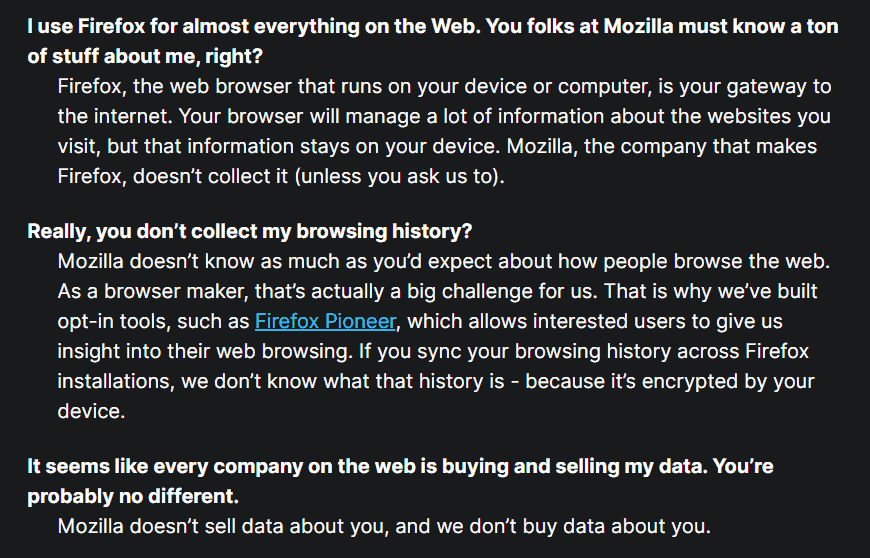
Source: Mozilla Privacy F.A.Q.
Firefox is available for all major platforms like Windows, Linux, macOS, Android and iOS.
Mozilla Thunderbird
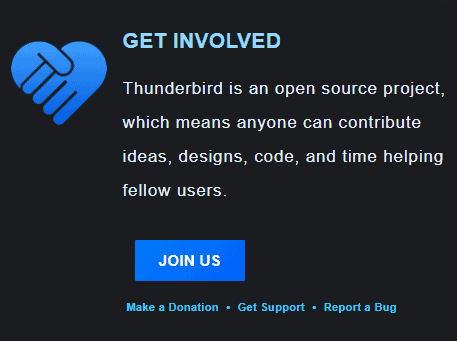
Source: Thunderbird’s website
Thunderbird extends its functionalities with the tons of add-ons available on their website. These add-ons allow you to make the already great software much more powerful.
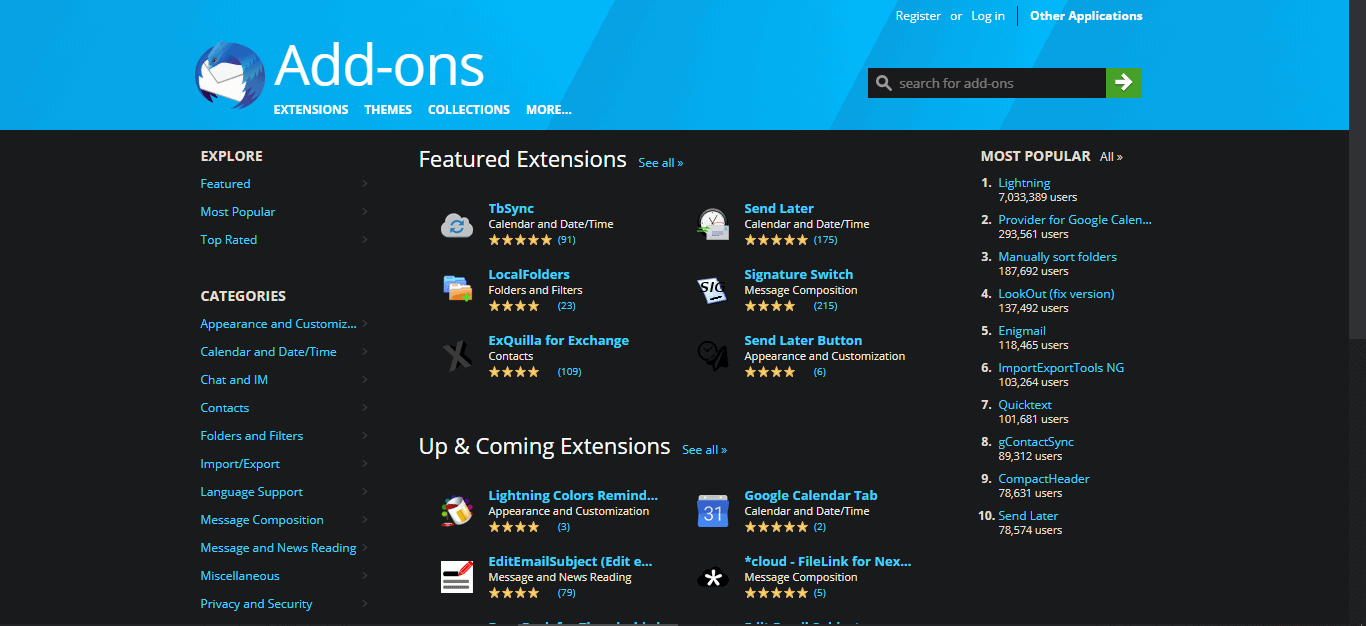
Source: Thunderbird’s website
Thunderbird also stays committed to user privacy. It is very strict about sharing user data and uses it only and only where it is necessary. It is available for Windows, Linux and macOS.
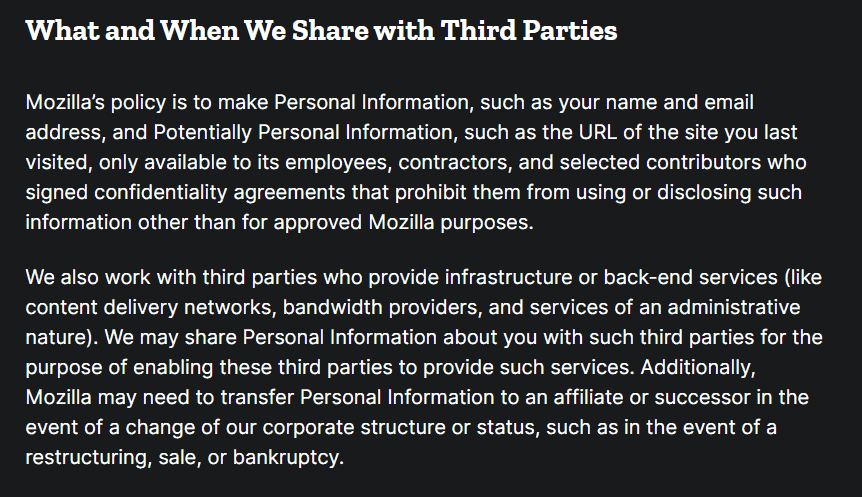
Source: Thunderbird Privacy Policy
Pocket App
This is a different product. Pocket isn’t something Mozilla built from the ground-up. It became Mozilla’s part when Read It Later, Inc. was acquired by Mozilla Corporation in 2017. Pocket lets its users save online content like articles and videos from any app or page and then consume and share at their own ease. It provides seamless integration between mobile apps and its web interface all of which provide a superb experience.
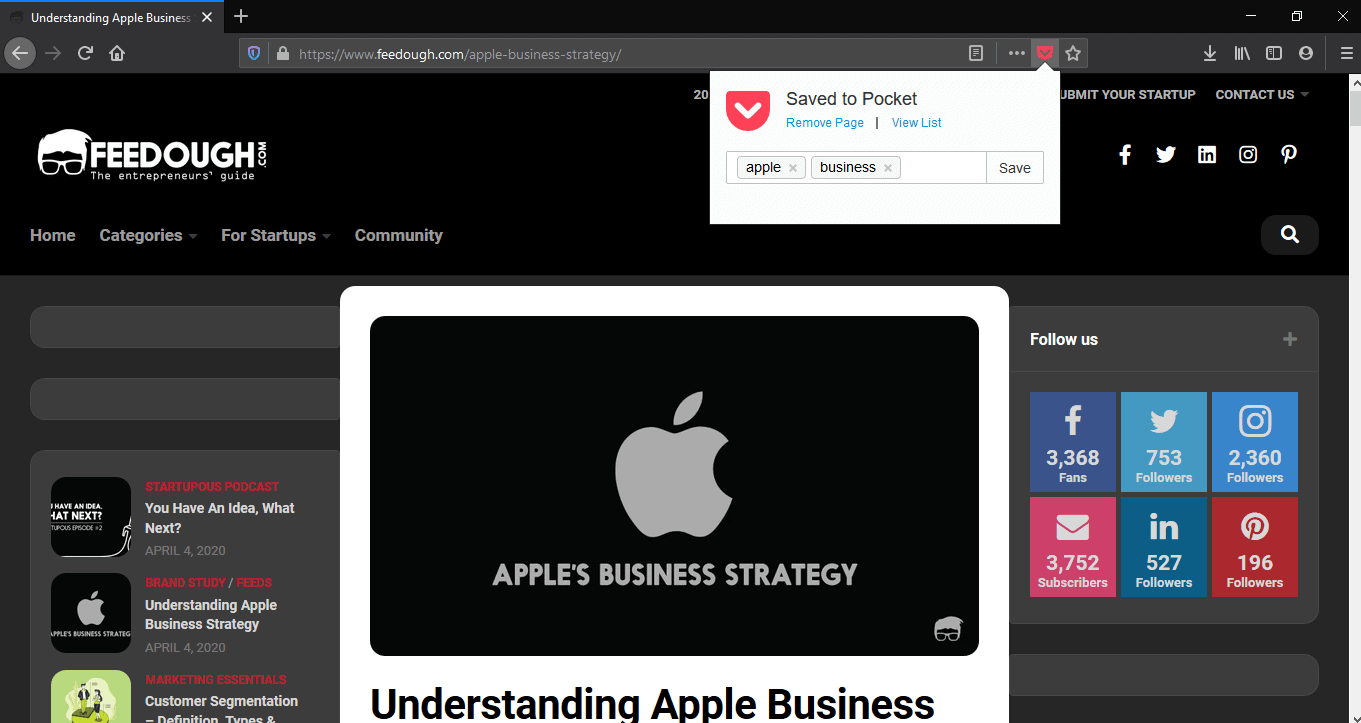
Saving an article on Pocket
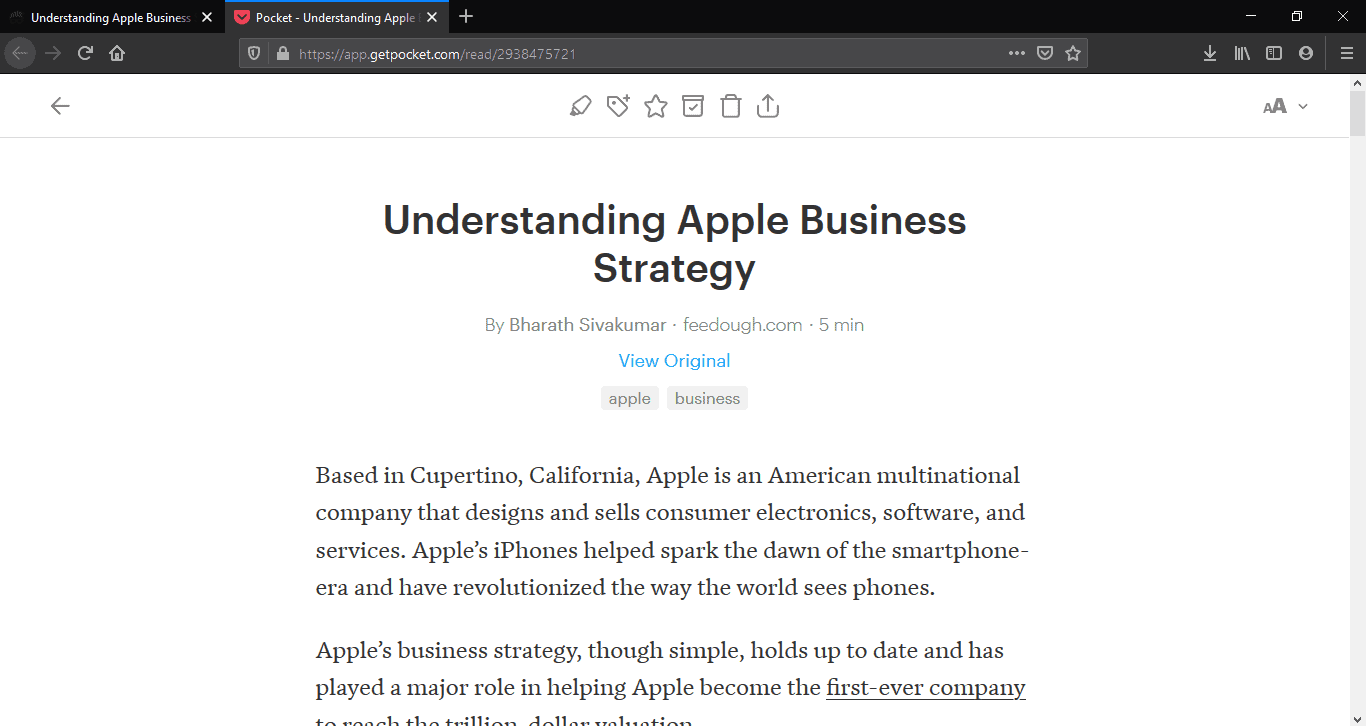
Pocket reader with features like sharing, tags etc.

Discovery section in Pocket
As Mozilla’s first strategic acquisition, it was done to promote “discovery and accessibility of high-quality web content”. They looked at pocket as a medium for users to consume and share content on their own terms for an independent and decentralised experience. Pocket is available on Android, iOS and the web.
Mozilla is a crucial contributor to the online open-source community. They actively develop and work on lots of projects to improve the quality of the internet for users. Rust, Servo, MDN web docs are all Mozilla’s work to name a few. They also provide grants and donations to individuals and groups working in the same direction as Mozilla.
Mozilla also keeps on experimenting into new areas. Since progressing internet into the right direction for users (or humans) is a major part of Mozilla’s mission, stepping into new zones to progress their ideology has been a key part of their operations. Firefox Reality is a very recent example of this.
Final thoughts
It didn’t have to be this way. It still doesn’t, but the mind that is incapable of admitting when it is wrong, or of considering differing opinions is doomed to stagnation and decay. The decision makers of Mozilla appear to have such minds so I do not hold out much hope for the future. Hopefully some of you out there can at least learn from their mistakes and succeed where they are failing. You succeed by giving users what they want, not telling them what they should want. By providing what is missing in the market, not blindly trying to copy your competitors.
The views and opinions expressed are those of the authors and do not necessarily reflect the official policy or position of It’s FOSS.
Author info: From Melbourne Australia, Dan has been coding for about 40 years and doing graphic design for 25 years. He also works on open source mechanical designs based on 3D printer kits.
The anatomy of the Yahoo deal: did Yahoo make money from the deal with Mozilla?
Distribution is a critical component of the search market. Search engines like , Yahoo, and Bing’s success depend on their ability to be featured on several devices on the web. The key middleman between a search engine and its user is a browser. While back in 2008 managed to launch its own browser, Chrome, Yahoo instead had to secure its distribution primarily via third-party browsers.
As reported on Yahoo financials for 2016:
As pointed out in the same report:
What were the additional revenues Yahoo recorded thanks to its Mozilla deal?
If we stick to the number given by Yahoo financials, it seems to be $394 million in 2015.
What cost does Yahoo have to bear for that distribution and traffic acquisition?
If we stick to this number, the traffic from Mozilla was priced for Yahoo at $375 million. Therefore, Yahoo recorded at least $19 million from the traffic coming from Mozilla Firefox.
What is Mozilla?
Mozilla is actually two things, the Mozilla Foundation and the Mozilla
Corporation, which are often confused and conflated in public
discourse. (There’s actually at least one other piece, but these two
are the main ones.) The Mozilla Foundation, founded in 2003 to take
over development of the source code for the Netscape web browser, is a
501(c)(3) tax-exempt nonprofit organization, with a staff of 80 people
and a budget of about $27 million in 2018, the last year for which
figures are available. The Mozilla Corporation, founded in 2005, is a
for-profit business, wholly owned by the Mozilla Foundation, with a
staff of about a thousand and revenue of about $440 million, again
from the 2018 financials.
This organizational structure was designed to allow the Mozilla
Corporation to engage in business activities which would be
incompatible with 501(c)(3) status, with a portion of the revenues
from those activities directed to the Mozilla Foundation to help fund
its activities. Having a nonprofit parent also means that the
management and employees of the Mozilla Corporation can help serve the
public benefit goals of the Mozilla Foundation, while still having
interesting jobs, being paid reasonably well, and feeling themselves
to be part of the overall Silicon Valley high-tech milieu.
Second: The customers of the Mozilla Corporation are not the users of
Firefox (among whom you may count yourself). The Mozilla Corporation’s
customers are large corporations like Google that pay for things that
will help them make money, most notably having their Internet search
service be the default in the Firefox browser. And to complete the old
saying, “If you’re not the customer…”, then the 200+ million Firefox
users are the product, potential viewers of ads served up by Google or
others.
(The existence of the Firefox browser as a competitor to Google’s
Chrome browser also supposedly helps Google avoid unwelcome antitrust
attention, especially now that Microsoft has abandoned its own browser
development efforts to base its own browser on the Chrome code. But
it’s unclear how important this consideration actually is to Google
senior management.)
In the early days of the Mozilla Corporation these search engine
relationships proved extremely lucrative, jumping from less than $5
million in 2004 to over $50 million in 2005, the first year in which
the Mozilla Corporation reported financial results, and eventually
growing to a high of about $540 million in 2017.
But as the number of Firefox users decreases (due to the growing
market dominance of the Chrome browser), and those users click on
fewer online ads (for example, because they’re spending less during
the COVID-19 pandemic), the willingness of Google and other customers
to pay the Mozilla Corporation for those users decreases
accordingly. Thus the Mozilla Corporation cutting a quarter of its
workforce.
(In contrast, to my knowledge the Mozilla Foundation itself is not
laying off anyone, at least at this time. It gets its funding from a
combination of royalties from the Mozilla Corporation for use of the
Firefox and Mozilla trademarks, government and foundation grants, and
individual donations. For 2018 the royalties accounted for about half
of the Mozilla Foundation’s budget, with grants and individual donations
each accounting for about a quarter of the budget.)
So, if you’re an avid user of the Firefox browser and want to chip in
a few dollars to help support its development, there’s actually no way
for you to do so, at least not at present. Your donations will go to
the Mozilla Foundation, which will use them to help fund its outreach
and advocacy initiatives, of which it has several. The Mozilla
Foundation itself does not develop Firefox—or any other software, to
my knowledge.
Энрике Бернат
Энрике Бернат родился 20 октября 1923 года. Он придумал знаменитый леденец на палочке — «Чупа-Чупс».
Внимательный Энрике, будучи рабочим в кондитерской своего деда в Барселоне, заметил, что мамы часто ругают своих детей, за то, что они пачкаются карамельками. Тогда ему пришла в голову идея — сделать конфеты на палочках, чтобы детям было удобно их есть.
В 1958 году дед передал своё дело внуку. Когда Энрике Бернат возглавил компанию, он прекратил выпуск почти 200 видов сладостей и оставил карамель на палочке.
Энрике Бернат назвал их «Чупа-Чупс» (от испанского глагола «сосать»). Тогда же он переименовал и саму компанию в Chupa Chups. Сначала палочка у конфет была деревянная, затем её сделали пластиковой. С каждым годом популярность фабрики возрастала.
В 1961 году Бернат решил, что у леденцов должна быть запоминающаяся упаковка. Его друг — художник Сальвадор Дали за час нарисовал картинку, известную всему миру по сегодняшний день.
Сегодня «чупа-чупс» — одно из самых любимых детских лакомств во всем мире.
Текст: Анастасия Харламова
Александра Глаголева-Аркадьева (1884-1945)
Физик, изобретательница рентгеностереометра и открывательница коротких радиоволн
Первая русская женщина-физик, получившая мировую известность в научном сообществе. Выпускница физико-математического факультета Московских высших женских курсов.
В 1916 году Александра изобрела рентгеностереометр – прибор, измеряющий глубину залегания пуль и осколков снарядов у раненых. Продолжив исследования в этой области, Глаголева-Аркадьева сконструировала излучатель электромагнитных волн. С его помощью ученая первая в мире получила наиболее короткие радиоволны с длиной равной длине тепловых волн. Это открытие доказало единство световых и электромагнитных волн и стало сенсацией в мировой науке.
How Mozilla makes money
Mozilla makes money by charging its partners royalty fees for using its service.
It also earns through distribution deals of its open-source software. These fees account for nearly 95% of Mozilla’s revenues.
Mozilla originally had an agreement with the Yahoo! Search engine, but that deal ended in 2017.
Before signing with Yahoo!, Firefox was the chosen browser for Google, with Google being the partner for its search engine.
However, Yahoo! offered Mozilla a $300 million deal in annual royalties, swaying the company to choose Yahoo! as its partner.
After ending the deal in 2017, Google stepped up to replace Yahoo! as a Mozilla partner. However, the company only institutes the framework on the back end, and the Chrome browser remains Google’s chosen default. It was a strategic move by Google, but Mozilla earns royalties from Google, despite it not being the selected default for search.
There is no information on the amount Google spent in the deal to return Mozilla Firefox to its platform.
Still, experts suggest it was far more than the Yahoo! Deal. The Mozilla Foundation receives funding from the Mozilla Corporation, other foundations, and individual donors.
Amazon search also pays Mozilla royalty fees. Mozilla operates the Firefox store, helping the company generate revenue through app and extension sales and merchandise.
Mozilla runs the search backend of the site, allowing for fast, effective searches on the Amazon platform.
Some of the other partners generating income for the Mozilla Corporation include Yandex, Creative Commons, and eBay.
Its partnerships help the Mozilla Corporation earn millions in revenue each year. Current estimates put Mozilla’s annual earnings at approximately $72 million.
Poor memory management
If a program is sitting there doing nothing, its memory usage should not change. Looking at my memory manager I have 40 processes obeying this principle. What is the only program constantly reading and writing to disk despite doing nothing? Firefox. It is running 13 processes and all of them are constantly doing both. I’ve been coding for 40 years and building PC’s for 30 so I do know a thing or two about how computing works. This is just awful design at the base level and no amount of tinkering on the surface will fix that.
The code paradigm is the root of Mozilla’s performance issues and they won’t address it. I’ll wager that’s also the reason for the failure of FirefoxOS, which was a great idea but failed because of poor execution and coding practices resulting in too many bugs to fix.
Аунг Сан Су Чжи
Давайте рассмотрим некоторые обстоятельства нашего первого лауреата. Гнетущий, насильственный режим? Проверьте. Неограниченное политическое заключение? Проверьте. Это всего лишь один день в жизни Аунг Сан Су Чжи, возможно, одного из самых стойких политических диссидентов в истории и лауреата Премии мира 1991 года.
Однако ей не разрешили покинуть Бирму (также известную как Мьянма), чтобы получить свой приз, до 2012 года или двух десятилетий после победы. Тем временем она была задержана милитаристским режимом Бирмы, который рассматривал ее работу в области демократии и прав человека как угрозу для установленной структуры власти.
Аунг Сан Су Чжи фактически выиграла всеобщие выборы в стране в 1990 году. Но даже до того, как все голоса были подсчитаны, она была помещена под домашний арест и будет оставаться с таким перерывом до 2010 года. Чтобы отразить одиночество и отчаяние, она размышляла, она планировала и она упорствовала.
После ее окончательного освобождения из-под домашнего ареста она сразу же снова начала заниматься политикой. Партия, которую она возглавляет, Национальная лига за демократию, победила в результате оползня на выборах 2015 года, хотя ей запрещено становиться президентом из-за иностранного гражданства ее сыновей.
Рейтинг первых мировых товаров: лучшие продукты, которые изменили мир
Мир на протяжении своей истории сталкивался с различными технологическими, культурными и научными прорывами, которые привели к революционным изменениям. Важную роль в этих изменениях сыграли первые мировые товары, которые изменили ход истории. Разработанные и произведенные в разных уголках мира, они стали символами прогресса и стали глобальными феноменами.
Вот рейтинг первых мировых товаров, которые изменили наш мир:
- Стриженое мясо. В древности люди полагались на охоту и рыболовство для получения пищи. Но с изобретением огня и орудий для разделки дичи, появилась возможность стричь и готовить мясо. Это привело к развитию сельского хозяйства и дальнейшему расширению возможностей человека в области пищеварения и снабжения пищей.
- Рулонная бумага. Изобретение рулонной бумаги в разных культурах позволило людям писать и хранить информацию более удобным и доступным способом. Это способствовало распространению знаний и развитию образования.
- Книгопечатание. Изобретение печатного станка Йоханом Гутенбергом в XV веке стало одной из важнейших технологических революций в истории человечества. Массовое производство книг стало возможным, что привело к распространению знаний и широкому доступу к образованию, ведя к общей грамотности.
- Паровой двигатель. Изобретение парового двигателя Джеймсом Уаттом в XVIII веке стало началом промышленной революции. Это изобретение повлияло на процесс производства, транспорта и общественной жизни в целом. Паровой двигатель был основой для создания новых технологических открытий и привел к появлению автомобилей, поездов и пароходов.
- Электричество. Открытие электричества в XIX веке стало одним из самых значимых событий в истории. Электричество стало основой для энергии и освещения. Это привело к созданию множества устройств и технологий, которые дали толчок к прогрессу и развитию жизни во всех сферах.
- Интернет. Изобретение интернета в конце XX века полностью изменило мир. Интернет стал основой для мирового информационного пространства и мгновенного обмена информацией. Он привел к революции в сфере коммуникации, торговли, образования и технологий.
Это лишь некоторые примеры первых мировых товаров, которые изменили мир. Каждый из них стал ключевым моментом в истории человечества и привел к переходу к новой эпохе развития. Эти товары постепенно изменяли мир и оказывали глубокое влияние на жизнь людей во всех ее сферах. Без них наш мир был бы совершенно другим.
ВОЗМОЖНОСТИ БРАУЗЕРА FIREFOX
Вместо того, чтобы нагромождать браузер большим количеством функций в изначальной поставке продукта, Firefox имеет механизм расширений и плагинов, что позволяет конечным пользователь изменить функционал браузера на свои нужны.
Браузер Firefox на сегодняшний день являет самым гибким браузером с наибольшим количеством возможностей. Конечный пользователь имеет возможность устанавливать плагины, темы, а так же расширения, которых на данный момент уже великие тысячи.
Данная гибкость достигается исключительно за счет встроенного в движок Gecko собственного языка разметки XUL, который так же использует Javascript и CSS в своей основе. Что на самом деле не всегда благотворно влияет на скорость работы браузера, так как потребление ресурсов у данного браузера более высоки, чем в остальных.
Герман Мюллер
Для каждого технологического прогресса есть компромиссы и потенциальные побочные эффекты
Благодаря работе Германа Мюллера, который получил Нобелевскую премию по физиологии и медицине 1946 года, люди осознали важность уравновешивания наших знаний безопасностью и заботой
Мюллер выиграл свой приз за доказательство того, что рентгеновские лучи вызывают мутации (называется Рентгеновский мутагенез) в организме человека. В середине 1920-х годов он собрал значительные доказательства того, что облучение мух дрозофилы рентгеновскими лучами вызвало генетические мутации, которые сократили их продолжительность жизни. Он был уверен, что такой же ущерб будет у людей.
Хотя он пытался обнародовать свою работу около 20 лет, потребовались атомные бомбардировки Второй мировой войны в Японии, чтобы подчеркнуть опасность радиации, рентгеновских лучей и радиоактивных осадков. Именно тогда Нобелевский комитет наконец признал его исследования.
Открытия Мюллера, а также его политика против ядерного оружия сделали его бесценным противовесом изменяющимся в мире техническим достижениям атомного века.
Анна Межлумова (1914-2007)
Химик, изобретательница 95-го бензина
Эта удивительная женщина является изобретательницей 95-го бензина, которым заправляет автомобили большая часть водителей в нашей стране.
Анна окончила Грозненский нефтяной институт, а затем пошла работать в НИИ нефтяной промышленности, в котором проработала почти всю жизнь — до 80 лет. Получив приказ от высших руководителей государства (по слухам — напрямую от Сталина), группа ученых под руководством Межлумовой начала работу над усовершенствованием топлива.
Результатом исследований стала разработка бензина с наиболее высоким октановым числом. Помимо этой работы, Анна Межлумова — автор 19 изобретений в области нефти и синтетических масел.





























